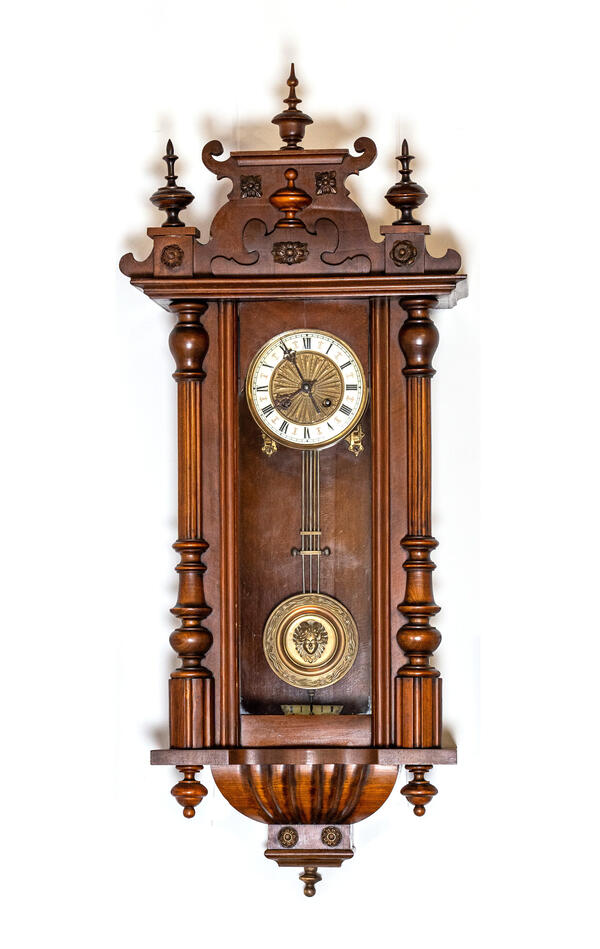The front panel of the clock is framed on both sides by chiseled semi-columns on wide short plinths and has a transparent glass insert. The insert is framed with a decorative edging with a fold and an arched inserted strip in the upper part. There are also transparent glass inserts in side walls. The clock face is metal, with a white lining around the circumference marked with Roman numerals and divisions. There are 2 holes for winding the movement and transferring the hands at the bottom of the clock face. The pendulum is a dark yellow metal disc mounted on 5 vertical rods with 2 bridges in the lower part. A medallion with a bas-relief image of a human head is the center of the disc. A ribbon with an engraved circular pattern of iris stems and flowers is around the medallion, along the outer edge of the disc.
Irises have been popular since ancient times. Their images are found on the frescoes of Ancient Egypt, Assyria and Babylon. Then those flowers personified the strength and steadfastness of the power of the ruling house and were called to inspire the awe of the subjects. Among Christians, irises symbolized purity, protection, but also became a symbol of sorrow and pain. Iris as a religious symbol first appeared in the painting of the early Flemish masters, and it is present both with the lily and instead of it in the images of the Virgin Mary.
In 1344, the first clock with a 24-hour movement and striking was assembled for the palace in the city of Padua. Starting from 1345, a hour was divided by 60 minutes, and a minute — by 60 seconds.
In 1410, a bell ringer was fired because of unrestrained drunkenness in the French city of Montpellier. Striking clocks began to perform its functions. This was the first documented case of a human being replaced by a machine in history.
In 1630, the clock face was first covered with glass. In the middle of the 17th century, a clock in a double case appeared: its outer part protected the inner one from mechanical damage. Around 1750, craftsmen started covering the clock faces of clocks with enamel, making the numbers easier to read, and the product itself lasted longer and retained its aesthetic appearance.
Striking wall clocks are either pendulum or balancing. Pendulum clocks are installed motionless, since the mechanism of their operation is based on vibrations. First wall clocks appeared at the end of the 16th century. It was observed that the accuracy of the mechanisms depended on the length and weight of the pendulum.
Irises have been popular since ancient times. Their images are found on the frescoes of Ancient Egypt, Assyria and Babylon. Then those flowers personified the strength and steadfastness of the power of the ruling house and were called to inspire the awe of the subjects. Among Christians, irises symbolized purity, protection, but also became a symbol of sorrow and pain. Iris as a religious symbol first appeared in the painting of the early Flemish masters, and it is present both with the lily and instead of it in the images of the Virgin Mary.
In 1344, the first clock with a 24-hour movement and striking was assembled for the palace in the city of Padua. Starting from 1345, a hour was divided by 60 minutes, and a minute — by 60 seconds.
In 1410, a bell ringer was fired because of unrestrained drunkenness in the French city of Montpellier. Striking clocks began to perform its functions. This was the first documented case of a human being replaced by a machine in history.
In 1630, the clock face was first covered with glass. In the middle of the 17th century, a clock in a double case appeared: its outer part protected the inner one from mechanical damage. Around 1750, craftsmen started covering the clock faces of clocks with enamel, making the numbers easier to read, and the product itself lasted longer and retained its aesthetic appearance.
Striking wall clocks are either pendulum or balancing. Pendulum clocks are installed motionless, since the mechanism of their operation is based on vibrations. First wall clocks appeared at the end of the 16th century. It was observed that the accuracy of the mechanisms depended on the length and weight of the pendulum.



